MIG welders can be used for a range of projects including autobody work, hobby welding projects, maintaining equipment, contract work and many other things. MIG welding is often chosen as a preferred welding method as it produces good quality welds and it’s easier to learn than TIG welding.
Contents
- What is the Best MIG Welder for You?
- Best MIG Welder Comparison Chart
- What are the Best MIG Welders?
- 1. Hobart Handler 210
- 2. Lincoln PowerMIG 210MP
- 3. Hobart Ironman 240
- 4. YESWELDER MIG-205DS MULTI-PROCESS
- 5. Miller Millermatic 211
- 6. Hobart Handler 190
- 7. Lincoln EasyMIG 180
- 8. Hobart Handler 140
- 9. Miller Millermatic 141
- 10. Forney 318 190
- 11. Lincoln EasyMIG 140
- 12. Everlast Poweri 140e
- 13. Lincoln K2185-1 Handy MIG
- 14. Forney 308 140
- 15. Forney Easy Weld 261 140FC
- Factors when Selecting a MIG Welder
- Maintaining your MIG Welder
- Other Equipment for your Welder
- Final Thoughts
What is the Best MIG Welder for You?
When buying a welder, there is a range of factors to consider such as price, metal thickness, input voltage, weight, duty cycle and more. We have written our recommendations based on our experience.
In this MIG Welder Buyer’s Guide, you can find explanations of the best welder for your needs and a summary of why these are the best. We have also written more in-depth product reviews which you can read and a description of the different factors to consider when choosing your welder.
Click any of the links below to find which welder is best suited for your needs.
- Best MIG Welder for Beginners
- Best MIG Welder for the Money
- Best MIG Welder Under $1250
- Best MIG Welder under $500
- Best MIG Welder under $300
- Best Dual-Voltage MIG Welder
- Best 110/115/120v MIG Welder
- Best 220/230/240v MIG Welder
- Best MIG Welder for Small Projects
- Best Gasless MIG Welder
Best MIG Welder Comparison Chart
Below is a comparison chart of the best Mig welders on the market today. We've included a full range of welders from small, beginner welders to heavy industrial welders.| Welder | Image | Max Amp | Volts | Process | Duty Cycle | lb | Rating | Price | More |
|---|---|---|---|---|---|---|---|---|---|
Hobart Handler 210 Best Under $1250 Best Under $1250 Best Dual Voltage Best Dual Voltage | 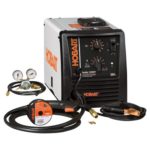 | 210 | Dual | MIG/Flux | 30% @ 150A | 79 | 4.9/5 | $$$ | Review |
Lincoln PowerMIG 210MP Best multiprocess Best multiprocess Best under $2000 Best under $2000 | 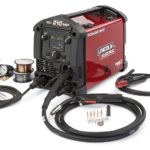 | 220 | Dual | MIG/Flux/ Stick/TIG | 25% @ 200A | 40 | 4.8/5 | $$$$ | Review |
Hobart Ironman 240 Best 220v MIG Best 220v MIG | 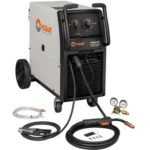 | 280 | 220V | MIG/Flux | 65% @ 200A | 186 | 4.8/5 | $$$$ | Review |
Yeswelder MIG 205 Best under $500 Best under $500 Best budget MIG Best budget MIG | 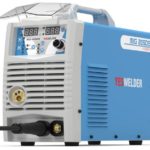 | 205 | Dual | MIG/Flux/ Stick/TIG | 60% @ 205A | 23 | 4.7/5 | $ | 10% Yeswelder Discount Code: KINGSWELDING |
| Miller Millermatic 211 |  | 230 | Dual | MIG/Flux | 40% @ 150A | 38 | 4.7/5 | $$$$ | Review |
| Hobart Handler 190 | 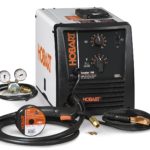 | 190 | 220V | MIG/Flux | 30% @ 130A | 79 | 4.7/5 | $$ | Review |
| Lincoln EasyMIG 180 | 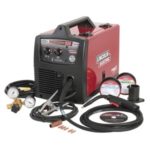 | 180 | 220V | MIG/Flux | 30% @ 130A | 66 | 4.7/5 | $$ | |
Hobart Handler 140 Best 110v Overall Best 110v Overall Best for Beginners Best for Beginners | 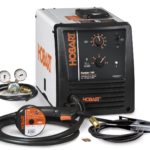 | 140 | 110V | MIG/Flux | 20% @ 90A | 57 | 4.6/5 | $ | Review |
Miller Millermatic 141 Best 110v if Money isn't an Issue Best 110v if Money isn't an Issue | 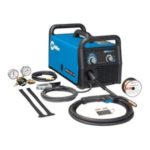 | 140 | 110V | MIG/Flux | 20% @ 90A | 51 | 4.5/5 | $$$ | Review |
| Forney 318 190 | 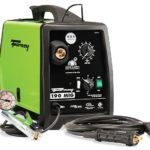 | 190 | 220V | MIG/Flux | 25% @ 120A | 63 | 4.5/5 | $$ | Review |
| Lincoln Easymig 140 | 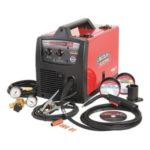 | 140 | 110V | MIG/Flux | 20% @ 90A | 50 | 4.5/5 | $$ | Review |
| Everlast Poweri 140e | 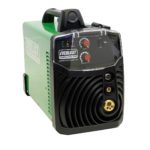 | 140 | 110V | MIG/Flux | 60% @ 90A | 57 | 4.4/5 | $ | Review |
Lincoln K2185-1 Best for Small Projects Best for Small Projects | 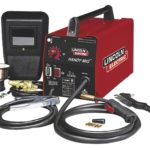 | 88 | 110V | MIG/Flux | 20% @ 70A | 46 | 4.4/5 | $ | Review |
| Forney 309 140 | 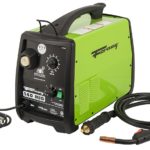 | 140 | 110V | MIG/Flux | 35% @ 90A | 57 | 4.2/5 | $ | Review |
Forney 261 140 FC Best flux only Best flux only Best under $300 Best under $300 | 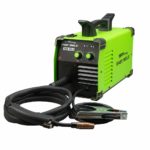 | 140 | 110V | Flux | 30% @ 90A | 19 | 4.2/5 | $ | Review |
What are the Best MIG Welders?
1. Hobart Handler 210
![]() Best dual voltage
Best dual voltage ![]() Best under $1250
Best under $1250
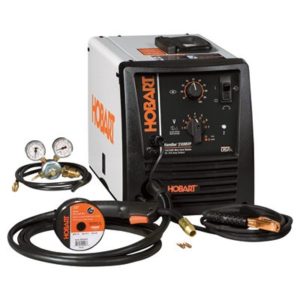 |
|
The Hobart Handler 210 has the typical great quality Hobart build with durable parts that stand the test of time. The 210 is more suited to autobody repair and construction than the 190 and 140 and it welds up to 3/8 inch. It’s also a flexible unit with the capacity to weld off 115V and 230V. At under $1250 it’s lot cheaper than the Ironman 230 and is a wise choice if you’re looking for a welder that packs real power but isn’t the price of the heavy industrial welders. It you’re looking for the all round MIG package for power, versatility, quality and value for money, the Hobart 210 is our top pick. See our full review of the Hobart Handler 210 here.
|
Specifications
|
Pros
Cons
|
2. Lincoln PowerMIG 210MP
![]() Best multi-process
Best multi-process
![]() Best under $2000
Best under $2000
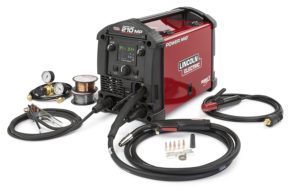 |
|
The Lincoln PowerMIG 210 is the ultimate MIG welder for versatility. It comes with the capability to perform MIG, stick, fcaw and lift TIG but you’ll need an additional foot pedal kit. This is perfect if you’re looking to buy a MIG welder and are considering buying a TIG or Stick welder as well. Buying a multi-process welder like the PowerMIG 210 can save you a lot of money rather than buying separate machines. Lincoln are the market leaders when it comes to manufacturing quality and the PowerMIG 210 is top of the range to build quality and weld quality. The digital display on the front of the machine lets you easily key in your variables to get you get set up in no time at all with an easy to use user interface. See the full review here.
|
Specifications
|
Pros
Cons
|
3. Hobart Ironman 240
![]() Best 220V MIG welder
Best 220V MIG welder
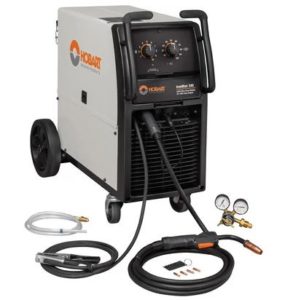 |
|
The Hobart Ironman 240 is updated Ironman 230 and it’s a really powerful welder that can comfortably weld 1/2 inch steel in single phase with fantastic arc quality. This new power packs even more power than the 230 and goes up to 280A and has a better duty cycle of 60% duty cycle at 200A. What’s great is that they’ve kept it a similar price. It’s a huge unit, but there’s wheels to help move it around, and a build in cylinder rack to store your gas cylinder. Most hobbyists won’t need a welder this powerful, but if you want a reliable MIG welder with a bit of extra power, this is our top pick. It still has 12 different voltage settings and infinite wire speed control.
|
Specifications
|
Pros
Cons
|
4. YESWELDER MIG-205DS MULTI-PROCESS
![]() Best under $500
Best under $500 ![]() Best budget MIG welder
Best budget MIG welder
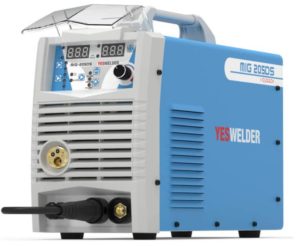 |
|
10% off discount code: KINGSWELDING
Yeswelder have become one of the major players in the welding equipment market over the past few years, mainly through their immensely popular range of budget welding helmets, and they’ve now started creating their own welding machines as well.
It’s quite unbelievable how they’ve managed to put a welder on the market for such a cheap price. Most of us started out skeptical about the quality of these and how they’d stand the test of time, but they have held up really well.
For under $500 you can get a selection of features that have typically only been available to welders with much higher budgets. It’s compatible with 110V and 220V with over 200A power to give you more options on how thick metal you can weld. But best of all is that it’s not only capable of MIG, flux core and stick, it’s also capable of lift TIG with additional Yeswelder kit. This is an amazing feature if you want to try your hand at TIG welding in the future and don’t want to pay an extra few hundred bucks for a TIG welder.
The main downsides of this machine are that the user interface isn’t the best and a lot less intuitive than Lincoln and Miller machines. It also doesn’t have settings on the inside of the case like many other brands which is why we haven’t rated it as well for beginners who will need more detailed instructions and guidance.
As for other cool features of this machine, it lays really nice weld bead, it has a really compact, lightweight design, the duty cycle is really well rated, the case is made from metal, the 2T/4T switch and it has synergic control MIG.
Overall, this is an amazing lightweight machine with professional capabilities and is definitely our favorite MIG welder for the money.
You may find the price is cheaper on Amazon, however, take into consideration that you get better customer support if you purchase from the Yeswelder website and you can also use our 10% off discount code provided. We’ve supplied links to both Yeswelder and Amazon above.
|
Specifications
|
Pros
Cons
|
5. Miller Millermatic 211
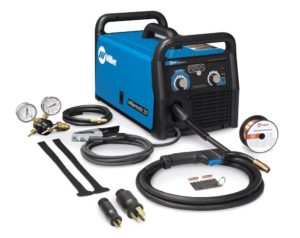 |
|
Miller have spent time crafting a machine to the highest manufacturing standards that is perfect for reducing set up times and welding up to 3/8 in steel. The most notable feature is the Advanced Autoset feature which gets you welding out the box in no time. All you have to do is select your wire diameter, process type and metal thickness and you’re good to go. You can input your parameters manually if you’d prefer, but the Autoset is so advanced that you really won’t need to, the arc quality is spot on. It’s a versatile unit that is dual-voltage and is super lightweight so it’s easy to carry with the handle on the top. There are plenty of other fine details in this machine like the ‘Auto Spool Gun Detect’ which can automatically detect a spool gun and ‘Smooth-Start Technology’ to enable smooth welds. You have to pay a bit more for this welder, but you get a quality machine with fine attention to detail. See the full review here.
|
Specifications
|
Pros
Cons
|
6. Hobart Handler 190
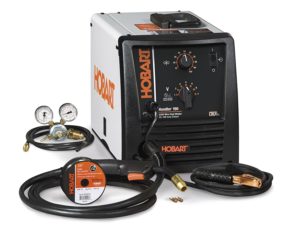 |
|
Another quality machine from Hobart that has 25A for 190A output range so you can weld up to 5/16 in steel. The power input is only 230V so you won’t be able to use this on your standard household power outlet. The 190 is a wise choice if you’re considering buying a 140A welder but think you may want to upgrade in the future. It’s not much more expensive and you can always turn the 190 down but you can’t turn a 140 up. There’s loads including for the price, you get power, durability, a good duty cycle and all the extras you need to get started, including .030 contact tips, 0.30 flux cored wire and gas gauges. See the full review here.
|
Specifications
|
Pros
Cons
|
7. Lincoln EasyMIG 180
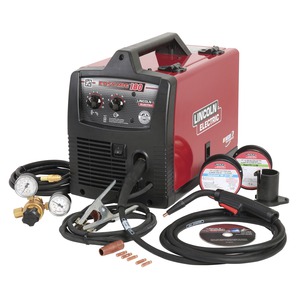 |
|
The Lincoln EasyMIG 180 is a well-built welder that’s reliable and will serve a range of light fabrication and workshop projects. Its power input is 230V but it doesn’t have the power of the Hobart 190. This is a great entry level 230V welder that will give you quality welds. It won’t tackle thicker metal but this will do the job for most hobby welders. It’s a great choice for a hobbyist if you have a convenient 230V power outlet.
|
Specifications
|
Pros
Cons
|
8. Hobart Handler 140
![]() Best 110v MIG welder
Best 110v MIG welder![]() Best for beginners
Best for beginners
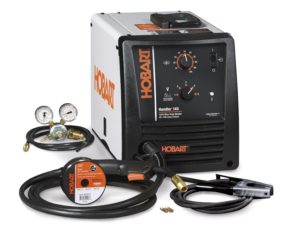 |
|
The Hobart Handler 140 is an excellent choice for beginner welders, which is why it’s probably the most popular welder on the market. This thing is solidly built and is a step above many of the other 140A welders. The arc runs smooth and produces great results. It’s suitable for a range of general repair tasks and projects like trailer frames, autobody repair and anything up to 1/4 inch thick. If you’re just getting into welding, you can’t go wrong with this little machine! There’s a great settings chart on the inside of the box to help beginners choose the right weld parameters. See the full review here.
|
Specifications
|
Pros
Cons
|
9. Miller Millermatic 141
![]() Best 110v if Money isn’t an Issue
Best 110v if Money isn’t an Issue
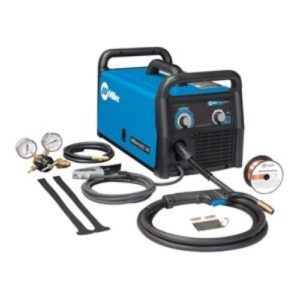 |
|
If you’re a beginner welder but don’t mind splashing the cash for a top of the range welder, then try the Millermatic 141. Miller have really pushed the boundaries of usability with this welder and it features an auto-set feature for an easy set up, and infinite voltage and wire speed control. All you have to do is select the thickness of the metal you’re welding and you’re ready to start welding straight away. If you open up the machine you can tell that all the parts are great quality and really durable as well. There are more powerful welders on the market for the price, but there’s nothing better for welding up to 3/16 inch steel. See the full review here.
|
Specifications
|
Pros
Cons
|
10. Forney 318 190
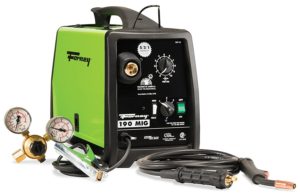 |
|
Forney have built a simple, mid range MIG welder that’s solid and reliable. It has some good power for the price but doesn’t have as good a duty cycle as the Hobart 190 or Lincoln 180. Forney aren’t one of the big three brands but this machine is still solidly built and I’d feel comfortable buying this. If you want a basic 220v welder without any special features, this is a good choice. Read the full review here.
|
Specifications
|
Pros
Cons
|
11. Lincoln EasyMIG 140
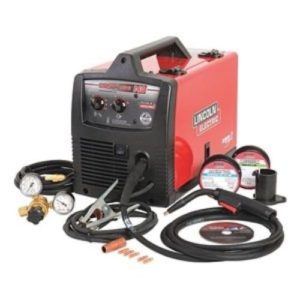 |
|
The Lincoln EasyMIG is a reliable 110v MIG welder. It doesn’t have the versatility of infinite wire feed speed like the Hobart and Miller 140A MIG welders and doesn’t offer the same value for money as the Hobart Handler 140, making it a less popular model. See the full review here.
|
Specifications
|
Pros
Cons
|
12. Everlast Poweri 140e
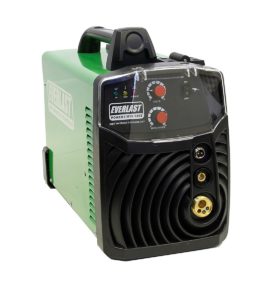 |
|
The Everlast Poweri 140e is a really lightweight due to its IGBT inverter technology. There’s no welding chart on the inside which is a useful feature that more MIg welders have. The duty cycle is much better than other 110v welders and it performs 60% @ 90A. At just 28lbs it’s perfect for contractors or hobby welders who want something they can use every now and then and carry it about. See the full review here.
|
Specifications
|
Pros
Cons
|
13. Lincoln K2185-1 Handy MIG
![]() Best for small welding projects
Best for small welding projects
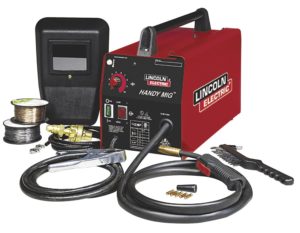 |
|
The Lincoln Handy MIG is a popular beginners’ welder. It’s not very powerful, and it only welds up to 1/8 inch steel, but this is still enough for most general home repair projects. This is really easy to use for beginners and is available at a good price for a Lincoln welder. This is the perfect welder for small projects where you’re not looking to weld over 1/8 inch but want a welder that won’t take up too much room and isn’t too expensive. See the full review here.
|
Specifications
|
Pros
Cons
|
14. Forney 308 140
 |
|
The Forney 309 140A welder is immense value for what you get. At comfortably under $500, you’ll struggle to find a welder as reliable or good quality anywhere for the same price, and it has a better duty cycle that most 120V welders. Forney have also recently upgraded this model in response to customer feedback to make it even better. It’s a simple design with no extra features but it does the job well.
|
Specifications
|
Pros
Cons
|
15. Forney Easy Weld 261 140FC
![]() Best gasless MIG
Best gasless MIG![]() Best under $300
Best under $300
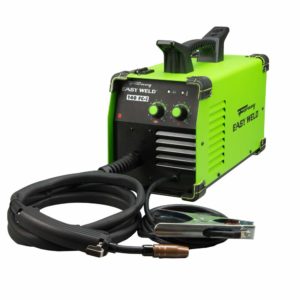 |
|
The Forney Easy Weld Flux Core welder is an amazing option for beginners who are looking to weld without gas. This is a flux core only machine so you won’t get the same weld quality as MIG but you can save a lot of money with a extremely portable machine. You can weld up to 1/4 plate steel and it weighs just 19lbs so you won’t need to buy a cart to put it on. This is definitely one to look at if you’re thinking of welding for the first time and have a budget under $300.
|
Specifications
|
Pros
Cons
|
Factors when Selecting a MIG Welder
1. MIG/Flux-Cored Welders or Multifunction
MIG welders are either flux cored, require a gas cylinder, or have the capability for both. Flux core welding might be appealing because you don’t need to hook up a gas cylinder to your cylinder, but flux core creates a layer of slag which needs to be chipped away.
Most of the welders on the market have both the MIG and flux core functions, however, there are some that have just one of these. I would generally recommend a welder with both of these functions available to ensure you have the maximum diversity.
2. Input Voltage
MIG welders have different input voltages so they might not be compatible with the electrical outlet where you are welding. Most welders are either 110/115/120V or 220/225/230V, but some have the capability for both.
110 Volt Welders
These lower input voltage welders are perfect for if you’re a hobby welder as you can plug them into a household power outlet. The only downside of this is that it limits the output power and you won’t be able to weld thicker metals without increasing your power and amperage.
220 Volt Welders
If you’re planning on working on some more powerful welds on thicker metals you’ll need a 220 volt welder. This means you’ll need a 220V power outlet installed. These welders are useful if you’re working on remote sites or industrial welding where you might not have access to a 110V outlet.
3. Output Power
You will need to have a different output power depending on what you’re trying to weld. Many manufacturers will include a chart with the welder to help you choose the correct settings to help you get the highest quality weld.
Below is a chart which shows an estimate of metal thickness and the required output power to achieve this.
| Gauge | mm | Required Amps |
| 8 | 4.2 | 165 |
| 10 | 3.4 | 135 |
| 12 | 2.7 | 105 |
| 14 | 1.9 | 75 |
| 16 | 1.5 | 60 |
| 18 | 1.2 | 48 |
| 20 | 0.9 | 36 |
| 22 | 0.8 | 30 |
| 24 | 0.6 | 24 |
4. Size & Transportability
When choosing your welder, you will need to consider the ease of transport of the machine, including its size and weight. If you’re planning on leaving it in your workshop, then weight might not be too much of a consideration. However, if you’re going to be working at multiple locations then it’s likely you will want a welder with a handle that isn’t too heavy to carry. If you need a large and powerful welder, you can of course store it in a cart on wheels, but the heaviest welders will still be hard to transport on concrete even with two people.
The smallest good quality MIG welders weigh 25lbs. These have inverter technology which reduces the weight significantly compared to the heavier transformer models. For the heavy industrial welders you can be looking at machines weighing 200lbs plus.
5. Spool Gun
If you’re planning on MIG welding aluminum, you will need to buy a welder with a spool gun. Many of the smaller welders do not come with the ability to do this so make sure you look out for it. For example, the Hobart 140 is a brilliant welder which does not include this. If you’re looking at buying a spool gun, I recommend one which has a quick release feature.
6. Duty Cycle
The duty cycle is a key factor concerning the length of time you’re looking to weld. If you need to use your MIG welder for a long time in one go, then you will need a welder with a high duty cycle. Duty cycle is shown as a percentage, this percentage will be the percentage of a 10 minute period that the welder can be operated before it overheats. For example, a 40% duty cycle could be operated for 4 minutes and would need a 6 minute cooldown period.
Often you will see that the higher the output power of your welder, the lower the duty cycle will be, as it takes a longer time to cool down. Small welders without a cooling system also have a low duty cycle. Fortunately, many large welders also have powerful fans to reduce the cool-down time.
If overheating is something you’re worried about, then you should buy a welder with thermal overload protection which prevents any damage to the welder by stopping the process if the duty cycle is exceeded.
7. Brand & Warranty
You want to choose a reliable and trustworthy brand for your welder. Welder manufacturers offer different levels of support, but generally, you will find that Hobart, Miller, Everlast, and Lincoln are the best quality and stand the test of time.
Always check the warranty on your welder and don’t risk buying a cheap welder with a poor warranty. Hobart and Longevity welders come with a fantastic 5-year warranty, these are high-quality anyway, but this warranty gives you extra assurance in your investment. If you’re considering welders by less well-known brands then make sure you thoroughly research their reviews and testimonials.
8. Price
Choose the welder which matches your budget and is best suited for your needs. Don’t approach your purchase with a “the most expensive will be the best” attitude, as this will usually not be the case. If you understand what you’re looking for, or if you have a budget, then you can accurately pick the welder which will save you the most money and give you the best performance. Our guides below will help you choose the best welder for your needs.
Maintaining your MIG Welder
One of the ways to ensure you get quality welds is by looking after your welder and it maintains high performance levels for longer. MIG welders do not need much maintenance, but little things can make the difference in the long run.
Cover
If your workshop is particularly dusty, put a cover over your MIG welder when you’re not using it. Dust can get into welders and damage them over time so it’s better to keep it covered. Most welder manufacturers sell covers for specific models.
Drive Rolls
As wire is continually fed through the drive rolls, dirt can build up on the rolls. Blow some air through the rolls or brush them down every few uses to clear out the dust.
Contact Tips
Keep your contact tips clean on your MIG gun. Sometimes spatter gets stuck to the contact tips which can cause porosity. If you have lots of spatter stuck to the tip then this will limit the flow of shielding gas that protects the bead from contamination. Use nozzle dip to coat the tip and help prevent spatter from sticking to it.
Other Equipment for your Welder
Before you can get started with your welder you will need to have all the right equipment to keep you safe and ensure you get the best possible weld. Below are the other pieces of equipment to consider for use with your welder.
1. Gas Cylinder
When MIG welding you will need to use a gas cylinder. Different types of welding require different types of gas. The most popular type of MIG welding gas is Carbon Dioxide because it has the lowest operating cost. CO2 is a low alternative to other gases which are a mixture of CO2 and Argon, these mixes are more expensive but will provide a higher weld quality and reduced spatter that Co2. You can also use Pure Argon if you’re welding magnesium or titanium, but this should not be used if you’re welding ferrous metal such as steel.
2. Regulator
You will need to attach a regulator to your gas cylinder before you can use it. There are different types of regulator you can buy, including gaugeless, single gauge and dual gauge. Dual gauge regulators are slightly more expensive and will show two things on the gauges – how much gas is left in the tank, and a flowmeter to set the flow depending on which gas you are using. The single gauge regulators will show how much gas is left in the bottle on the gauge and you will have a non-gauge flowmeter.
3. Torch
Usually when you buy your welder it will come with a torch, but you should check to make sure it does.
4. Welding Mask
Your welding mask is the most important piece of equipment to have when you are MIG welding. When you are MIG welding, the arc is incredibly bright and damaging to your eyes. You need a helmet to protect you from this and to allow you to see the weld pool. The price for these varies, with the most expensive masks being the auto-darkening helmets which help you see your work and position the torch with ease.
5. Clothing
When welding you should wear the correct clothing, cotton or leather clothes with long sleeves and welding gauntlets are a must. Any flying sparks are extremely hot and you do not want this to touch your skin. If you’re wearing synthetic material then you should change to cotton or leather as the heat from the spark could make this stick to your skin and burn you.
Final Thoughts
Too many people end up buying a welder which isn’t what they wanted, so I set up this guide to help you choose the best welder for your needs. I tried to include as much information as I could in this guide and present it in an easy to understand way, but if you have any questions or feel there is anything I have missed, please leave a comment and I’ll answer it the best I can.
We hope you liked our article “The Best MIG Welders in 2020” if so, we’d really appreciate it if you could rate and share it.
best
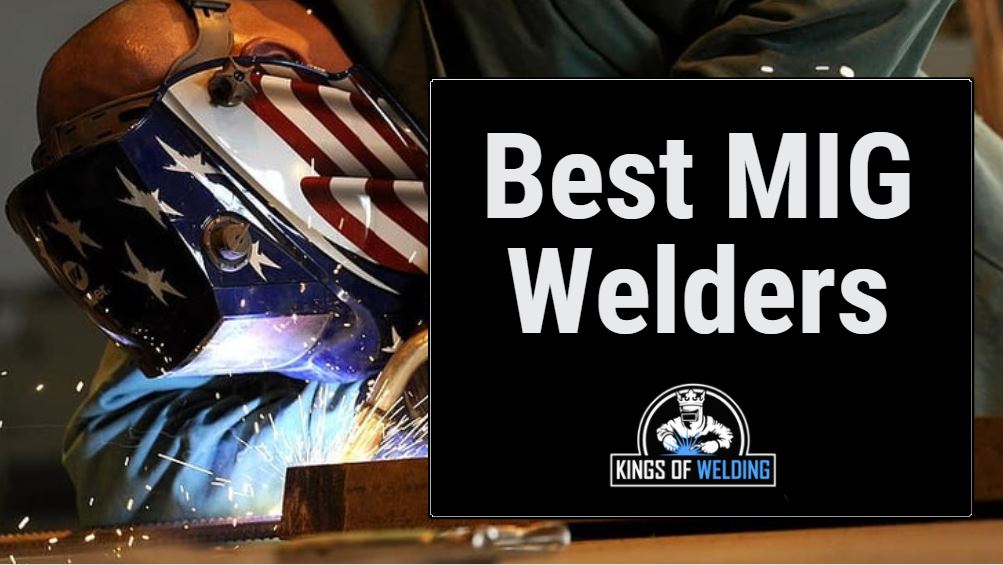
 (4.5 / 5)
(4.5 / 5) (5.0 / 5)
(5.0 / 5) (4.9 / 5)
(4.9 / 5) (4.8 / 5)
(4.8 / 5) (4.7 / 5)
(4.7 / 5) (4.0 / 5)
(4.0 / 5) (3.5 / 5)
(3.5 / 5) (4.6 / 5)
(4.6 / 5) (4.4 / 5)
(4.4 / 5) (3.0 / 5)
(3.0 / 5) (4.2 / 5)
(4.2 / 5)
Thanks for the guide, just ordered a Hobart 140 as a late christmas present!
Hi Wayne,
Thanks for the message and I hope you’ve enjoyed using it!
John
I recently ordered the Lincoln 210 as my first welder. It is incredible and I feel like a pro! Thanks for the advice.
Hi Max,
Thank you! Glad you like it, the Lincoln 210 is a beauty.
Cheers,
John
Hi John,
I’m thinking of getting the Lincoln Handy MIG because it’s cheap and lightweight. I’m just worried it won’t be powerful enough. What metal thickness can this handle?
Thanks,
Dave
Hi Dave,
Thanks for your comment. The Handy MIG welds up to 1/8 in. mild steel. If you’re worried it’s not powerful enough then I’d recommend the Hobart 140 for not much more money.
Thanks,
John
Questions:
-as a tool user who hates having to buy one tool to learn with, only to have to upgrade later, I’d rather buy the right tool for the intended usage the first time.
my projects would be primarily around the house projects and personal auto hobby and think my requirements would be adequately filled with a unit that has 110/220 option, Speed and Arc control, and Fluxcore/MIG capability, and able to handle 24gauge up to (I dunno) 1/4″. Is there such a beast, or am I just asking for too much as a non-welder?
-why can you only weld up to 1/8″ with some welders? if you’re doing butt-welding aren’t you just filling in the ‘V’ with weld?
-you state “The Hobart Handler 140 is good for small-medium sized projects”, but in the description you say “It’s suitable for a range of general repair tasks and projects like trailer frames, autobody repair and anything up to 1/4 inch thick” . What determines the size of the project? I would think a trailer frame to be a large project.
Hi Tom,
I agree with you there, for a lot of people it’s definitely a case of if you buy cheap, you buy twice.
Sounds like the most suitable welder for you is the Hobart 210. It’s dual voltage, good value, and can do up to 3/8″. The Hobart 140 does weld up to 1/4″ but you’re better to go a bit over, also it’s not dual voltage.
For the size of the project I was more referring to the size of the weld. You’re right a trailer frame is physically large but might only be 1/8″ thick, so I would’t call it large in this context.
Hope that helps, let us know what you go with and how you get on.
Cheers,
John
Mp K3964-1 is versatile and has strong sheet-metal construction. It is ideal for most DIY repairs at home or a small shop. It can be plugged into any conventional power supply. It has dual voltage inputs of 120V or 230V. This multi-functional MIG welder can also be used as a stick welder or TIG welder. It s also got many positive MIG welder reviews by Tig welders on welding forums, so if you ever choose to TIG weld something or you just want to learn TIG welding, this is the right rig for you.